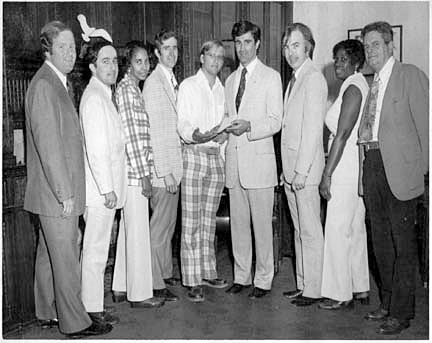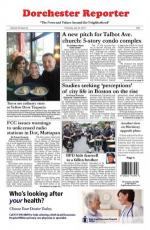December 4, 2024

Codman Square Health Center Incorporated: Pictured during an April 1975 ceremony, from left: State Rep. W. Paul White, City Councillor Larry DiCara, Doris Brown, John MacNeil, Bill Walczak, Secretary of State Paul Guzzi, Craig Wall, Mona Scantlebury, and Charles Murphy. Photo courtesy Bill Walczak
For several decades I’ve had the privilege of giving public health tours of Codman Square, which I have called a “nonprofit innovation district.” In this half-mile district there are amazing nonprofits that have inspired people from around the world to think “outside the box” when figuring out how to tackle what oftentimes seem to be intractable problems.
My tours typically start at the north end of Codman Square at 450 Washington St., where Daily Table, the grocery store that only sells nutritious food at low-cost, shares space with the HealthWorks at Codman fitness center and a Teaching Kitchen. The space, owned by the Codman Square Health Center, also houses a volunteer operation to provide free tax services for eligible residents.
Our tour next heads south down Washington Street, pointing out the headquarters of the Codman Square Neighborhood Development Corporation, which has developed hundreds of units of environmentally sustainable housing for low-income residents. We may also visit the Epiphany School, which provides free middle school education and an amazing array of services to the students and their families for life. The Epiphany School also runs an early childhood center in which services begin for parents during pregnancy.
We end the tour at the campus that the Codman Square Health Center and Codman Academy share at the southern end of the square. This campus, which was, and may still be, the only co-located K-12 school/health center in the country, has been able to introduce its high school students from the greater Dorchester community to careers in health, which, at 18 percent of all jobs in greater Boston, is the largest single employment sector, and one that generally pays middle class wages. In addition, students get paid summer internships, and about 30 are being trained to be certified in pharmacy, radiology, phlebotomy and doula, jobs that will offer them an opportunity to get higher paid summer jobs when they go to college.
Since I have spent my life mainly in health care, most of my tours involve people from the health care sector. Over the past few years, I’ve given health-oriented tours to people from the Netherlands, Malaysia, and Chile through programs at Dartmouth, MIT, and Harvard. Recently, a group of 50 health professionals from Chile came to Boston to learn about the American health care system. It’s a program that typically ends with a visit to Codman Square to learn about community health centers, and to see how the health center connects with the other nonprofits to provide holistic support to patients.
This visit, however, happened on Nov. 6, the day after Election Day. Knowing that the Chileans would likely be very interested in hearing a public health perspective on the election, I started by noting that the election would probably result in the naming of Robert F. Kennedy Jr. (RFK) as Secretary of Health and Human Services. I explained that RFK is an extreme skeptic on the use of vaccines, which save the lives of millions of children a year, who would like to ban fluoride, which saves millions of teeth.
In addition, with President-elect Trump’s statement that he wanted RFK “to go wild on health…. I’m going to let him go wild on the medicines,” I thought it might not be worthwhile to get into a discussion on the value of American health policy.
Instead, I discussed community activism. Through this election, Americans have proven once again that they are skeptical of government’s ability to solve problems. But Americans can and do take action on their own and have a long history of doing so.
Alexis DeToqueville, the early 19th century French observer of American culture and author of the two-volume “Democracy in America,” wrote: “These Americans are peculiar people. If, in a local community, a citizen becomes aware of a human need that is not being met, he thereupon discusses the situation with his neighbors. Suddenly, a committee comes into existence. The committee thereupon begins to operate on behalf of the need and a new community function is established. It is like watching a miracle.”
DeToqueville’s observation brings to mind the origins of the Codman Square Health Center. It was 50 years ago this month – Dec. 10, 1974 – that the Codman Square Civic Association (a precursor to the Codman Square Neighborhood Council) established a Codman Square Health Committee. Its purpose was to determine if a community health center could be sited into the soon-to-be-closed Codman Square branch library, now the Great Hall in Codman Square. For months, there had been an awareness that the branch library would close. The civic association was in communication with Boston’s Department of Health and Hospitals and the nearby Carney Hospital about whether putting a health center would be supported by the city and the Carney.
The president of the civic association, Marge Muldoon of Kenwood Street, invited representatives from existing Dorchester health centers and the Carney Hospital to speak on how they were able to start their health centers, which was still a new concept. The first of these in the entire country was the Columbia Point Health Center, which opened in 1965. At the community meeting were Ethel Lenox, a founder of the Uphams Corner Health Center, Jean Hunt, a founder of Neponset Health Center, Pat Edraos, a founder of the Bowdoin Street Health Center, and Sr. Kathleen Natwin, head of Ambulatory Care at the Carney Hospital, which supported the development of several local health centers. They constituted a panel and spoke for a few minutes about how their health centers were started, the health needs they addressed, and how the centers were making a difference in their communities.
Codman Square was in a terrible state at the time. Much of the commercial district was vacant and/or decrepit. Residential housing values had plummeted as the city lost 30 percent of its population. Many houses went vacant for lack of a buyer at any price, resulting in arson fires. Crime was on the upswing and people’s faith in their own community was suffering. The private physicians who provided primary care services in the area were moving out or not taking new patients, so new residents used hospital emergency rooms for basic primary care.
Starting a health center seemed like a great idea. Not only would it be a way to show that positive things could happen in Codman Square, but it also would meet a great health care need, and could utilize a building which, the community believed, would be burned down if it became vacant.
Mrs. Muldoon chose a group of volunteers at the end of the presentation to form the Codman Square Health Committee. The purpose of the group was to investigate whether a health center was feasible, and, if so, to create one. President Muldoon asked the person who asked the most questions about starting a health center to chair the committee, and that person was me, despite my age (I was 20).
A group of about 20 people from the neighborhoods around Codman Square started meeting in January. In a few months, the group determined that a health center was indeed feasible and in April 1975, the members decided to incorporate as a way of getting the job done.
The group that formed the Codman Square Health Center 50 years ago had no idea of the challenges that were ahead. It took four years of effort and struggles with the then-city administration and state health agencies before the doors finally opened in 1979, with five employees. Even then, most said that this new Codman Square Health Center would not survive.
Today, the center has several hundred employees, an annual budget of $55 million, more than 20,000 patients and 100,000 visits per year, with 100,000 square feet of commercial space in Codman Square. It helped create two charter schools (the Edward Kennedy Health Careers Academy and Codman Academy), the HealthWorks Fitness Center, Daily Table, Latin Academy Housing, and contributed to starting a farmers’ market, the BOLD teens, adult education programs, nutrition programs, and many more initiatives. It enhanced the idea that health centers could do more than medical services by being a hub for community development and positive change. Stewardship of the health center’s vision continues today under a dedicated volunteer board and the leadership of its new CEO, Dr. Guy Fish.
In my speech at the dedication of the Codman Square Health Center on Nov. 3, 1979, I congratulated these community volunteers who stuck together through four years of working, agonizing, and fighting with various officials and bureaucracies to establish the facility. And it all started with a committee.
Bill Walczak’s column appears regularly in The Reporter.



